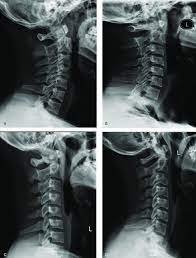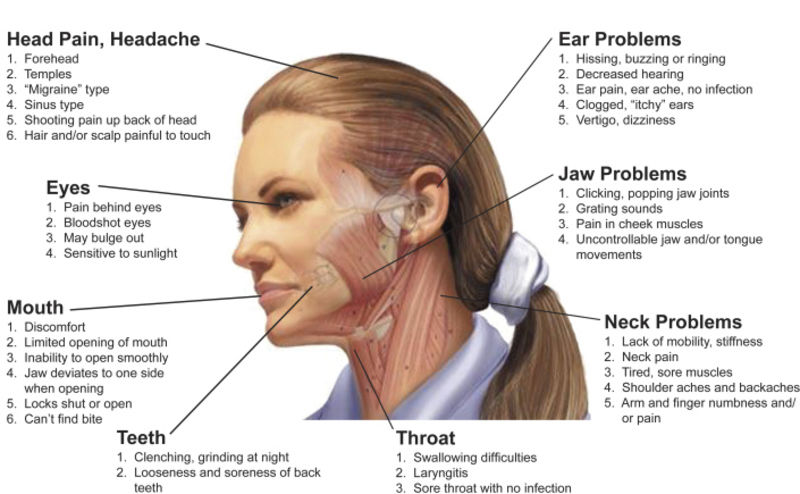What is neck curve?
The ideal neck curve is 33 degrees. Simply put; the neck curve should be shaped like a C or a banana. The neck curve is also known as cervical lordosis. The apex of the curve is forward facing; meaning it should be towards your nose when looking from a side profile. (see picture below - top left)
What’s so important about it though? Why do so many people who are suffering from pain happens to also have a compromised neck curve?
1. Spinal Support: The neck curve helps balance the weight of the head and provides support to the cervical spine. It helps distribute the forces and pressures experienced by the neck during various activities, reducing the risk of strain or injury.
2. Shock Absorption: The natural curve of the neck acts as a shock absorber, cushioning the impact of everyday movements and activities such as walking, running, and jumping. This helps protect the delicate structures of the cervical spine, including the vertebrae, discs, nerves, and muscles.
3. Range of Motion: The neck curve allows for a greater range of motion, enabling us to turn, tilt, and flex our heads comfortably. It facilitates smooth movement and flexibility, which are essential for daily activities like driving, looking around, and maintaining eye contact.
4. Nerve Function: The cervical curve helps maintain proper alignment of the spinal nerves, which exit the spinal cord through small openings in the vertebrae called intervertebral foramina. A healthy neck curve helps ensure optimal nerve function, promoting efficient communication between the brain and the rest of the body.
5. Postural Alignment: The neck curve contributes to overall postural alignment. When the neck curve is properly maintained, it helps align the head, neck, and spine in a neutral position, minimizing stress on the surrounding structures and reducing the risk of chronic pain, headaches, and other postural issues.
Trauma can potentially be the biggest affect to the natural curve of the neck. Injuries like whiplash or direct impact can cause misalignment; resulting in a loss of the normal curve. The five things listed above can potentially be all affected; not only in the neck but in the rest of the spine as well. See picture below; only one xray represents a normal neck curve - left upper corner. The rest of the neck xrays exhibit a compromised spine subject to varying ailing symptoms. With activities of daily living compounding onto a misaligned spine; pain and neurological symptoms can arise.
Have you been living with symptoms? Do you want to see if you are a candidate to benefit from NUCCA? Contact us for your consultation.
For more information check out: My Misalignment
Dr. Yu's story of how she found passion in NUCCA
Dr. Yu’s inspiration and passion for NUCCA chiropractic. Autism child nervous system thrives after NUCCA correction. Upper Cervical spine stability.
When someone first meets me; whether it is genuine interest or to simply make small talks…a question that usually float about is WHY? Why Chiropractic? Why NUCCA (of all things)?
As the saying goes…it found me. Here’s a story of a patient who has had a profound impact on my respect for NUCCA and the human body.
~~ Not too long ago, a child misbehaving badly, unable to play well with others, uncontrollable by normal standards were labeled as a child with poor upbringing, bad parenting, or even a future blemish to society. Now a days, those same characteristics lead to a diagnosis of autism. Autistic spectrum is wide that emcompass those with qualities of social, communication, and behavorial challenges. The cause is still unknown to the medical society. This article is not to debate the cause, but to highlight the miraculous change in little Michael's autistic life.
Michael, as he likes to be called Mikey, was diagnosed at the age of 5. His family's daily agenda transitioned to that very similar and common in any autistic household: the parents doing anything and everything in their power to find a cure for their child while maintaining a normal life. It included special education, artistic therapies, speech therapies, animal therapies, etc.
When mikey was 7, his mom found NUCCA care through another parent experiencing positive changes for their autistic child. After a two and a half hour one way car ride, they have finally found someone with the power and knowledge to help mikey. Mikey presented as a 7 year old trapped in a 5 year old's body. He was only able to express himself with screams and uncontrolled body language. His short attention span was easily captivated by mirrors, mom's familiar arms, and trucks passing by on the main road.
After a detailed examination and necessary xrays to mathematically calculate his atlas misalignment, little mikey was treated with NUCCA procedure. NUCCA is a gentle chiropractic approach without cracking, popping, or twisting to balance the spine. When the atlas is misaligned, the communication between the brain and the spinal cord are not able to communicate properly; causing neurological issues. After a week after mikey's first treatment, he started using words. Another week passed by and those word usage progressed to sentences. It may seem like a miracle story of a child learning to speak in 2 weeks. However, all these knowledge was within him and had been suppressed because of his atlas misalignment. There is no telling of what great things the body can do and heal when the brain can communicate well with the rest of the body. NUCCA is not just for autistic patients, but it is for anyone looking for vitality and pure health that is manifested from within.
Dr. Yu was interviewed for NUCCA news (fall 2018). There, you’ll be able to read a little more on her personal journey.
http://www.nucca.org/wp-content/uploads/2018/10/NUCCA_Fall18.pdf
Dr. Yu is a NUCCA chiropractor who is practicing again in Dallas after practicing in Sydney, Australia for 5 years. She graduated from University of Illinois in Urbana-Champaign with a major in Biology and minor in Chemistry before becoming a Chiropractor. She then continued her education at Parker University in Dallas, TX. She also has a Bachelor of Science in Nursing degree . She is a Reiki Master who does energy work on animals as well.
Biggest Stressor on the Human Body?
What’s the biggest stressor to the human body? How is this stressor a culprit of our aches and pains?
There probably has not been a need for you to think about the question: What is the biggest stressor on the body? But knowing the answer can be a HUGE “ah-HA!” moment for your health & wellness. In this day and age of fast paced society + technology, the typical answer to said question would be…Fast food/diet? Work? Financial stress? However, this answer rise above all the other correct answers. *drum roll* Its GRAVITY! You’re probably thinking…what on earth? How does Newton’s falling apple have any association with biggest stressor on the human body? Well, if you can imagine the downward pressure of gravity on an object, then you can imagine a force pulling your head straight down towards the earth. Think about you (representing gravity) and a soda can as the human body. If you’re trying to crush it with a vertical - straight down force…it is actually a bit more difficult than if there’s already a twist in the soda can. So if your atlas is misaligned, then it cannot support the weight of the head with its centre of gravity. The head “kinking” off at an angle would then create a twist in the spine much like that of a twisted soda can. This becomes a physical stress onto the body. Until the head is positioned again in its true centre of gravity, the stress on the body will remain.
Our spine compensates to the abnormal pressure resulting in a high shoulder and pelvis; maybe a twist to the hips also. This often then presents with symptoms of neck, back pain, headaches, knee pain, etc. We become the human version of Leaning Tower of Pisa.
What’s the remedy? Careful mathematical calculation of how the atlas is misaligned in relationship to the skull and also its relationship to the rest of the spine. It is only when we know where the problem is the only way to know how to fix it. To see if you may be out of alignment, contact your local NUCCA chiropractor.
The Jaw – Spinal Cord Connection A Simple Check-up Can Make All the Difference in One’s Overall Health
Are you a pain victim of your dental appliance? Why checking the upper neck alignment is key before dental work.
The TMJ can lead to many painful issues. Often times, its caused by misalignment of the C1/Atlas.
More often when we think of mouth guard, its a common need for athletes. Its also used as a daily/nightly dental protection device. Are both needed? The simple answer is yes and yes, but it is important to understand its function. A mouth guard is a covering that is placed on the upper or lower teeth to protect the teeth from injury.
There are two parts to the jaw: the maxilla, which is the upper part of the skull, or the non-moveable part with teeth, and the mandible, or the moveable part with teeth. The connecting location is the TMJ. What holds these two parts together are the muscles and ligaments, which are all controlled by facial nerves that come from the brainstem and are connected to the first vertebrae (also called the atlas).
A more thorough dental version of a mouth guard, known as an appliance, will also protect the temporomandibular joint (TMJ), from injury during periods of grinding and or clenching.
Over-the-counter mouth guards are manufactured predominantly in two premade forms that protect the teeth, but a custom appliance made at a dental office also maintains the balance between the upper and lower jaw so that dysfunction or destruction do not occur. Its focus is to maintain a proper fluid motion of the TMJ to avoid injury or pain. Symptoms of imbalance include tooth pain, facial pain, headaches and neck pain. Using the latest technology, dentists have tools to identify many problems in the TMJ to make better diagnoses and appliances that prevent further damage to teeth and the TMJ joint.
The use of a dental appliance is important for the treatment of several jaw-related problems and appliances are also being used to address sleep apnea and snoring with great success. However, another aspect of a patient’s well-being is how the fit of that appliance affects the neurological flow of the entire body.
If the atlas is in alignment and the brainstem is firing its signals correctly, allowing the nerves to function as they should, an improperly set appliance will put pressure onto the nerves and actually be capable of taking the patient out of alignment at the atlas, causing the nerves to not fire correctly, and giving way to symptoms such as headaches, vertigo, TMJ issues and even low back pain.
A simple check can determine if the dental appliance is affecting the spinal alignment and nerve flow. If the nerves are not firing correctly, that is considered a misalignment. If it is determined that the mouth guard is causing a misalignment, having that appliance refit by a dentist that understands the jaw/ spinal cord connection and can work with your spinal health practitioner is key.
While mouth guards and dental appliances are valuable protective tools for a patient to continuously feel well, the combination of having a properly set dental appliance and staying in alignment is key.



